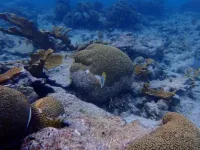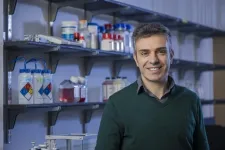(Press-News.org)
Through a quirk of anatomy, women are especially prone to urinary tract infections, with almost half dealing with one at some point in their lives.
Scientists have been trying to figure out for decades how bacteria gain a foothold in otherwise healthy people, examining everything from how the microbes move inside and stick to the inside of the bladder to how they deploy their toxins to produce uncomfortable and often painful symptoms.
Research published in PNAS examines how the bacteria Escherichia coli, or E. coli—responsible for most UTIs—is able to use host nutrients to reproduce at an extraordinarily rapid pace during infection despite the near sterile environment of fresh urine.
Investigators working in the lab of Harry Mobley, Ph.D., at the University of Michigan Medical School began by looking at mutant strains that weren’t as good at replicating in mouse models to identify bacterial genes that may be important for establishing infection.
Doing so, they identified a group of genes controlling transport systems as critical.
“When bacteria need something to grow, say an amino acid, they can get it in two ways,” explained Mobley, who is the Frederick G. Novy Distinguishes Professor of Microbiology and Immunology.
“They can make it itself, or they can steal it from their host using what we call a transport system.”
Their previous gene expression screen revealed that nearly 25% of bacterial genes were dedicated to replication tactics including transport systems for specific amino acids, which E. coli use to bring in thousands of molecules per second, said Mobley.
First author Allyson Shea, Ph.D., a former member of Mobley’s lab and now assistant professor of Microbiology and Immunology at the University of South Alabama, cross referenced a library of transport proteins from E. coli against other species of UTI pathogens to see which were important for infection. She discovered that a type of transporter called ABC (for ATP-binding cassette) transporters appeared to be critical.
Then using organ agar made from the mouse urinary tract, she confirmed that ABC transporters were essential for infection. Many bacteria strains lacking these nutrient import systems were defective for growth on bladder and kidney organ agar.
“It appears bacteria make an investment into these energy expensive ATP transport systems in order to have a higher affinity for the energy sources they are interested in,” said Shea.
“These systems are very, very good at getting nutrients inside the cell.”
The findings, Mobley notes, open avenues for the development of new therapeutics—which is especially important in an era of increasing antibiotic resistance.
“If you inhibit these transport systems, maybe you can inhibit the rapid growth of these bacteria,” he said.
Doing so won’t be easy, notes Shea, as bacteria have evolved multiple backups systems for this important class of transporters.
“What’s nice about this ATP-binding family is they all have an ATP binding subunit which gives the transport system the energy it needs to get nutrients across the cell membrane.”
This subunit could potentially be a target to make the entire family of transporters dysfunctional.
While this wouldn’t necessarily replace antibiotics, she says, it could slow down growth so that antibiotics and the host immune system could do a better job at stopping the bugs.
Additional authors include Valerie S. Forsyth, Jolie A. Stocki, Taylor J. Mitchell, Arwen E. Frick-Cheng, Sara N. Smith, and Sicily L. Hardy.
Citation: “Emerging roles for ABC transporters as virulence factors in uropathogenic Escherichia coli,” PNAS. DOI: 0.1073/pnas.2310693121
END
Households with gas or propane stoves regularly breathe unhealthy levels of nitrogen dioxide, a study of air pollution in U.S. homes found.
“I didn’t expect to see pollutant concentrations breach health benchmarks in bedrooms within an hour of gas stove use, and stay there for hours after the stove is turned off,” said Stanford Doerr School of Sustainability Professor Rob Jackson, senior author of the May 3 study in Science Advances. Pollution from gas and propane stoves isn’t just an issue for cooks or people in the kitchen, ...
Most people have heard the famous phrase “the enemy of my enemy is my friend.”
Now, Northwestern University researchers have used statistical physics to confirm the theory that underlies this famous axiom.
The study will be published on May 3 in the journal Science Advances.
In the 1940s, Austrian psychologist Fritz Heider introduced social balance theory, which explains how humans innately strive to find harmony in their social circles. According to the theory, four rules — an enemy of an enemy is a friend, a friend of a ...
The outbreak of a deadly disease called stony coral tissue loss disease is destroying susceptible species of coral in the Caribbean while helping other, “weedier” organisms thrive — at least for now — according to a new study published today in Science Advances.
Researchers say the drastic change in the region’s population of corals is sure to disrupt the delicate balance of the ecosystem and threaten marine biodiversity and coastal economies.
“Some fast-growing organisms, like algae, ...
Activated T cells that carry a certain marker protein on their surface are controlled by natural killer (NK) cells, another cell type of the immune system. In this way, the body presumably curbs destructive immune reactions. Researchers from the German Cancer Research Center (DKFZ) and the University Medical Center Mannheim (UMM) now discovered that NK cells can impair the effect of cancer therapies with immune checkpoint inhibitors (ICI) in this way. They could also be responsible for the rapid decline of therapeutic CAR-T cells. Interventions in this mechanism could ...
PHILADELPHIA — (May 3, 2024) — The Wistar Institute assistant professor Filippo Veglia, Ph.D., and team, have discovered a key mechanism of how glioblastoma — a serious and often fatal brain cancer — suppresses the immune system so that the tumor can grow unimpeded by the body’s defenses. The lab’s discovery was published in the paper, “Glucose-driven histone lactylation promotes the immunosuppressive activity of monocyte-derived macrophages in glioblastoma,” in the journal Immunity.
“Our study shows that the cellular mechanisms of cancer’s self-preservation, when sufficiently understood, can be used against the disease very effectively,” ...
Cambridge, Mass., – ADA Forsyth Institute (AFI) researchers received just under $10 million funding from the National Institute of Dental and Craniofacial Research (NIDCR) during the federal fiscal year 2023, placing 4th nationally on NIDCR’s ranking list.
“We have ranked in the top 5 dental institutions in 9 out of the past 10 years,” said Wenyuan Shi, PhD, Chief Executive Officer of AFI. “We have placed in the top 10 nationally every year since the ranking system began in 2002, despite having one of the smallest faculty ...
May 3, 2024—CHICAGO—The American Ornithological Society (AOS) is pleased to announce Judit K. Szabo, Ph.D., as the incoming editor-in-chief for its top-ranked journal, Ornithological Applications. Beginning on May 1, 2024, Szabo will work in partnership with the journal’s current editor-in-chief, Catherine Lindell, Ph.D., until June 30, 2024, and will take on full responsibility as editor-in-chief beginning on July 1, 2024. “With her international interest and network, conservation experience, and thoughtful approach ...
Long Beach, Calif. – May 3, 2024 – New data from the Acute Pulmonary Embolism Extraction Trial with the AlphaVac System (APEX-AX) demonstrated that catheter-directed mechanical thrombectomy is safe and effective in patients with acute intermediate-risk pulmonary embolism (PE) with significant improvement in the right ventricle (RV) function and minimal major adverse events. The safety and efficacy results from the prospective trial were presented today as late-breaking science at the Society for Cardiovascular Angiography & Interventions (SCAI) 2024 Scientific Sessions.
Pulmonary embolism (PE), a blood clot that blocks and stops ...
Long Beach, Calif. – May 3, 2024 – Late-breaking data from the ENGULF trial showed that a novel dual-action thrombectomy device was effective and safe in treating acute pulmonary embolism (PE). The safety and effectiveness results were presented today as late-breaking science at the Society for Cardiovascular Angiography & Interventions (SCAI) 2024 Scientific Sessions and simultaneously published in JSCAI.
PE is a serious cardiovascular event where a blood clot causes issues with blood flow and oxygen levels in the lungs. It can be ...
Long Beach, Calif. – May 3, 2024 – Recent findings from a study on a transcatheter heart valve (THV) system, which includes a new class of transcatheter aortic valve, showed positive results in the device's ability to function as a healthy and natural aortic valve in patients with aortic stenosis (AS). The late-breaking data will be presented today at the Society for Cardiovascular Angiography & Interventions (SCAI) 2024 Scientific Sessions.
AS is a thickening and narrowing of the aortic valve that can reduce blood flow to ...







